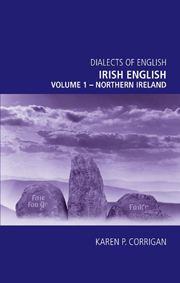1 - Geography, demography and cultural factors
Published online by Cambridge University Press: 12 September 2012
Summary
Geography and linguistic ecology
The subject matter of this book is restricted to varieties of Irish English and Ulster Scots spoken within the territory of Northern Ireland (henceforth, NIE/US). The region is highlighted in Figure 1.1 and was created as a result of the partition of Ireland. This followed the enactment of the Government of Ireland Act in 1920, creating the state of Northern Ireland (NI), which stayed within the territory of Great Britain, and the Republic of Ireland (ROI), which eventually became independent (see Dudley Edwards with Hourican 2005: 1–4; www.cain.ulst.ac.uk/issues/politics/docs/goi231220.htm). Its geographical extent is confined to six of the historical nine counties of what was once the province of Ulster (Figure 1.2).
The Ulster dialects spoken in the remaining counties, Donegal (in the extreme west), Monaghan (south of Tyrone and Armagh), Cavan (south of both Fermanagh and Monaghan) and Leitrim (south of Fermanagh) are examined in Kallen's companion volume in this series.
Figure 1.1 also demonstrates the proximity between NI and its neighbours on the island of Britain, which is relevant to issues of language contact to be explored in Chapter 5. Of particular interest is the short distance between the north-east coast of NI and the west coast of Scotland. Just 35 km separate the Ards Peninsula from Galloway and the 22 km separating Fair Head from Kintyre mean that permanent and seasonal migration between these places in both directions has always been common (Herity and Eogan 1996: 16–17; Holman 2007: 37–40; Kelly and Young 2004, §6.7;1 Montgomery and Gregg 1997: 569, §6.9; Otway-Ruthven 1968: 224–5; Russell 1995: 9–10).
- Type
- Chapter
- Information
- Irish English, volume 1 - Northern Ireland , pp. 1 - 28Publisher: Edinburgh University PressPrint publication year: 2010



